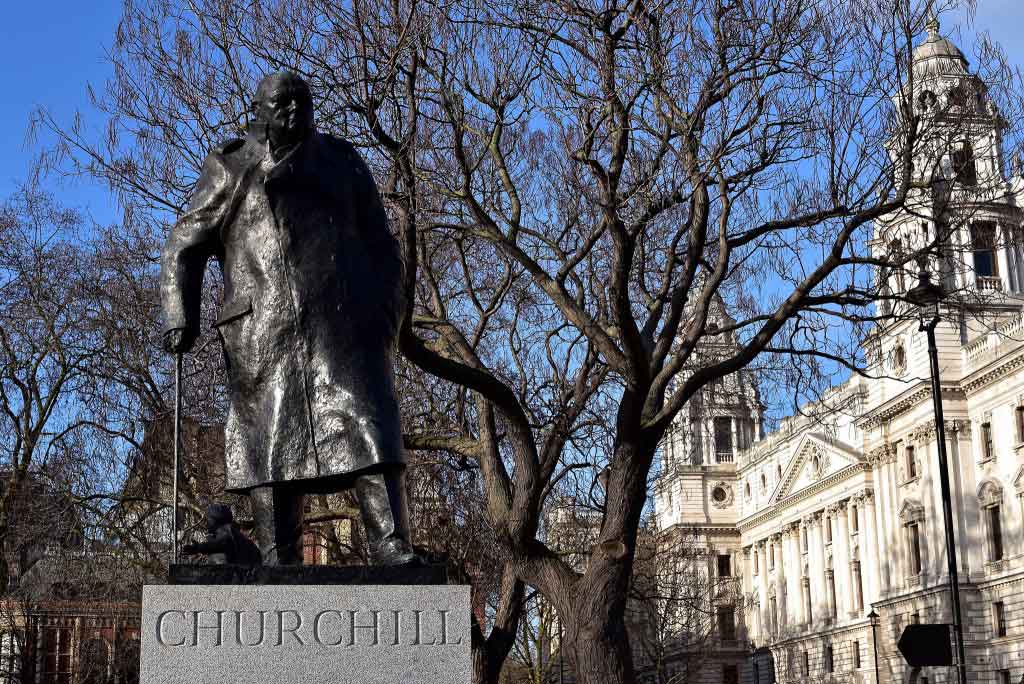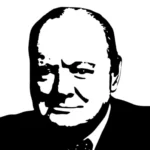Finest Hour 129
Riddles, Mysteries, Enigamas – Churchill’s Uniforms

Winston Churchill, Parliament Square, London © Sue Lowry & Magellan PR
June 29, 2013
Finest Hour 129, Winter 2005-06
Page 12
Riddles, Mysteries, Enigamas – Churchill’s Uniforms
Q: I am writing an article about Winston Churchill and require confirmation of the uniforms in which he appears during WW2 and after. He appears to have adopted uniforms to circumstances. The best I found is: First Lord of Admiralty when he was on a warship; RAF Air Commodore in France in 1944; Colonel of 4th Queen’s Own Hussars in Berlin in 1945 and France in 1947. Am I right?
—Jean-Louis Swiners, Editor in Chief
L’Encyclopédie du Leadership et de la Stratégie
Senior editor Paul Courtenay, our house expert on militaria, responds…
A: His nautical dress was that of the Royal Yacht Squadron, of which he was a member; there was no special uniform for the First Lord of the Admiralty.
His Royal Air Force uniform was that of Honorary Air Commodore of 615 (County of Surrey) Fighter Squadron, Royal Auxiliary Air Force; he was given this honorary appointment in 1939.
He wore two different Army uniforms. One was that of Colonel, 4th Queen’s Own Hussars; this was his original regiment in which he was commissioned from 1895 till 1899 (being appointed Colonel of the Regiment in 1941). The other Army uniform was that of Honorary Colonel, 4th/5th (Cinque Ports) Battalion, The Royal Sussex Regiment. He received this honorary appointment in 1941, soon after becoming Lord Warden of the Cinque Ports.
You can tell the difference between the two Army uniforms by their cap-badges and collar badges. The 4th Hussars’ cap-badges are gold-coloured and show a circular design surrounding the number IV, with a crown above. He wore this uniform in Egypt and Italy, also in Paris in 1947 when he was presented with the Médaille Militaire.
The cap-badge of 4th/5th Royal Sussex was larger: a silver cross with a plume behind; collar badges were similar, but in black metal. This uniform was worn prominently at Yalta, the Rhine Crossing, Berlin, Potsdam, and briefly in Italy.
If the Army cap-badge is not visible, look at the collar badges. Those of 4th Hussars are shiny; those of 4th/5th Royal Sussex are dull.
Many people think that his nautical uniform was that of an Elder Brother of Trinity House, but I have seen no photos of him wearing this in World War II. For examples of this uniform, which he wore at Antwerp in 1914, see Gilbert, Winston S. Churchill, vol. 3, The Challenge of War 1914-1916, plates 10 and 11.
He always wore his Royal Yacht Squadron dress when on board ship. He certainly wore 4th Hussars uniform when he was in the area where the regiment was located (Middle East). There appears to be no good reason why he preferred the 4th/5th Royal Sussex uniform, especially in 1945, since this battalion was not in the places he visited at that time. Perhaps he wore the RAF uniform when travelling by air, and certainly when visiting RAF units; also when he thought the population might appreciate the work of the RAF, e.g., Athens or Paris. He also wore it in Teheran (for no very good reason that I can see). As a whole, although some thought must have gone into his choice of uniform. I don’t think it was always precise. —PHC
Q: Upon meeting with Adenauer in 1953, Winston Churchill drew three circles on the back of a menu, symbolizing the United States, Europe and Great Britain. I am wondering if this drawing still exists, and/or whether there is a picture of it available? —Gunda Windmüller, Denmark
A: There certainly is some Konrad Adenauer correspondence, but this does not appear to be the menu in question, though you are most welcome to visit with us and check. I suppose it will all depend on whether the menu was kept by Churchill or Adenauer. However, the idea of the three overlapping circles representing the British Empire, America and Europe, with Britain at the Centre of all three, is an older Churchillian device. The earliest reference I have seen comes from an article written by Churchill in 1930 entitled “The United States of Europe.” I enclose a brief passage from an essay I have written which touches on this:
“…the key to understanding this article is an understanding of where Churchill saw Britain. This is what he says: ‘But we have our own dream and our own task. We are with Europe, but not of it. We are linked, but not comprised. We are interested and associated but not absorbed.’
“To Churchill Britain at that time was not just a European power. She was a global power. Her Empire gave her a presence in every continent. She should be prepared to act as a guarantor of Europe and to encourage and perhaps participate in schemes that brought Europeans closer together, but she also had the interests of her dominions to consider. And then there was the question of the United States. Churchill felt, perhaps because of his background more than most, that the shared language and culture gave Britain a unique position as the bridge between the old and new worlds. To quote the conclusion of his article: ‘Great Britain may claim, with equal justification, to play three roles simultaneously, that of an European nation, that of the focus of the British Empire, and that of a partner in the English speaking world. These are not three alternative parts, but a triple part…’”
—ALLEN PACKWOOD, DIRECTOR, CHURCHILL ARCHIVES CENTRE
Q: Can you please attribute a remark in which Churchill builds on the words of a French memoirist he admired, in regard to American soldiers arriving in France during World War I. Churchill allegedly said, “The impression made upon the hard-pressed French by this seemingly inexhaustible flood of gleaming youth in its first maturity of health and vigour was prodigious….”
—Salena Hastings, Pearson Prentice Hall, Boston
A: This is from Churchill’s World War I memoirs, The World Crisis, vol. III, part 2 (London/New York: Thornton Butterworth/Scribners 1927, Chapter XIX (“The Surprise of the Chemin des Dames”), page 454 of the English edition, which reads:
“Pierrefeu has described in a moving passage the next event. Now suddenly the roads between Provins and the front towards Meaux and towards Coulommiers began to be filled with endless streams of Americans. The impression made upon the hard-pressed French by this seemingly inexhaustible flood of gleaming youth in its first maturity of health and vigour was prodigious. None were under twenty, and few were over thirty. As crammed in their lorries they clattered along the roads, singing the songs of a new world at the tops of their voices, burning to reach the bloody field, the French Headquarters were thrilled with the impulse of new life. ‘All felt,’ he says, ‘that they were present at the magical operation of the transfusion of blood. Life arrived in floods to reanimate the mangled body of a France bled white by the innumerable wounds of four years.’ Indeed the reflection conformed with singular exactness to the fact. Half trained, half organized, with only their courage, their numbers and their magnificent youth behind their weapons, they were to buy their experience at a bitter price. But this they were quite ready to do.”
Jean de Pierrefeu was an officer on Pétain’s staff whose books on WW1 attracted Churchill’s interest when he was writing his own memoirs. More about Pierrefeau and the U.S. effort in France is at this website: www.randomhouse.com/features/americancentury/ goodtimes.html. —RML
Subscribe
WANT MORE?
Get the Churchill Bulletin delivered to your inbox once a month.



